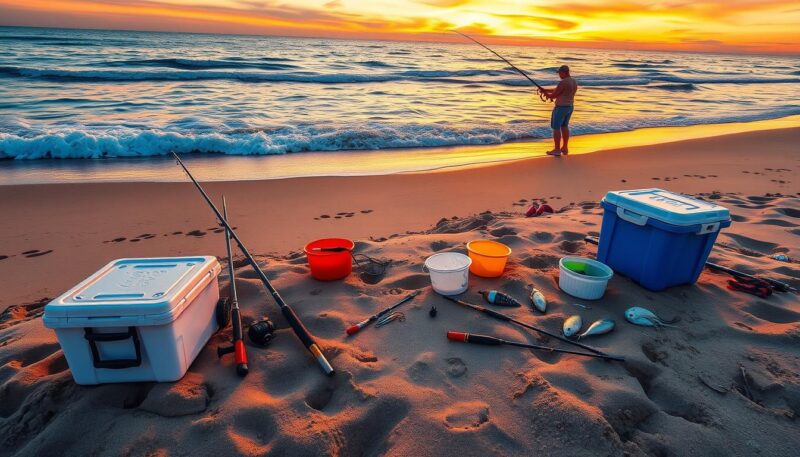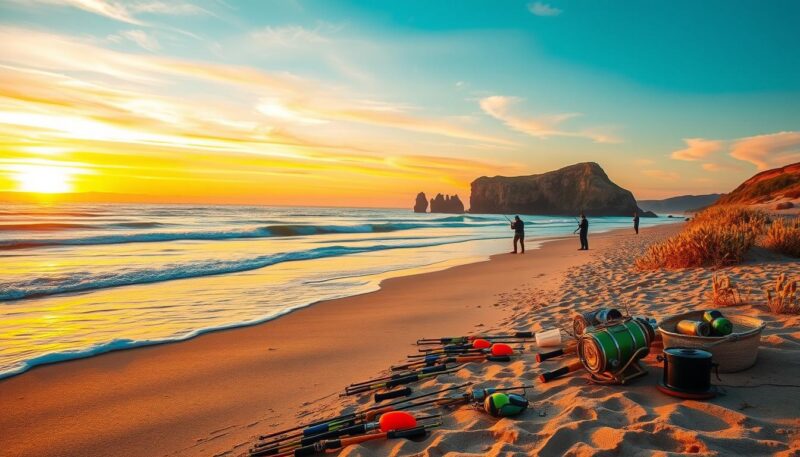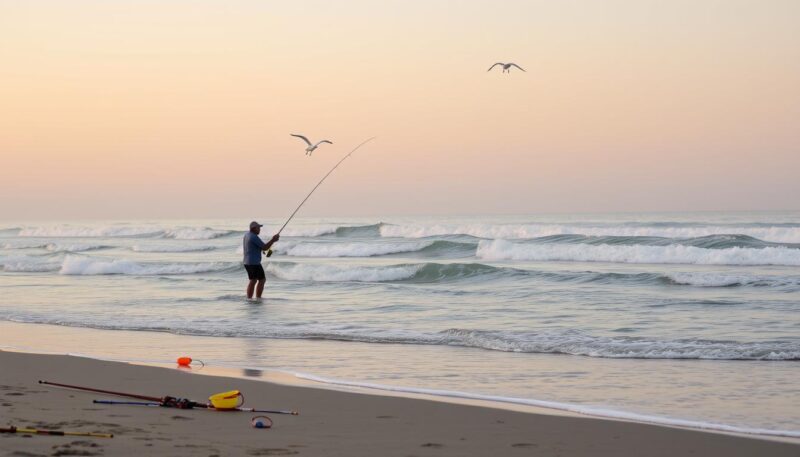Surf fishing is not just a way to catch fish; it’s an experience that connects you with nature while enjoying the great outdoors. This method allows anglers to cast their lines directly from the beach into the ocean, targeting a variety of saltwater fish species. If you’re a beginner looking to dive into the world of surf fishing, you’ll find that this sport is accessible, requiring relatively minimal gear and experience. In this surf fishing guide, we will cover essentials such as gear recommendations, effective techniques, and tips for the best fishing locations.
As you embark on your journey of surf fishing for beginners, you’ll learn to master your skills and increase your chances of catching fish in the surf. From targeting striped bass to flounder, there’s excitement in every cast. Whether you’re set on catching bigger species like sharks or simply enjoying a peaceful day by the water, this comprehensive guide will provide you with everything you need to know to enhance your surf fishing experience.
Understanding Surf Fishing
Surf fishing is an engaging and thrilling way to experience the coast while trying to catch various species of fish. This type of fishing occurs mainly in saltwater and allows anglers to cast lines from the shoreline into the surf. Understanding the surf fishing definition is key, as it not only involves the techniques used but also the types of fish you can catch and the conditions suitable for maximizing your catch.
Definition of Surf Fishing
Surf fishing refers to the practice of fishing from the shore in coastal areas, targeting saltwater fish that swim close to the beach. This versatile technique allows anglers to fish effectively in a range of water depths, sometimes even knee-deep. Strong casting abilities are important, as some specialized surf rods can achieve remarkable casting distances, making it easier to reach fish that may be lurking further offshore.
Types of Fish You Can Catch
When fishing for saltwater fish, you can expect to reel in a variety of species. Common catches include:
- Striped Bass
- Bluefish
- Flounder
- Pompano
- Snook
Each of these species has its specific preferences for bait and fishing conditions. For example, sand fleas are often used as bait when targeting pompano, while larger game fish, such as striped bass, can provide an exhilarating experience when caught from the beach. Engaging with different types of fish enhances the overall surf fishing experience.
What Is Surf Fishing? Gear and Techniques
A successful surf fishing experience hinges on having the right surf fishing gear and mastering essential surf casting techniques. Understanding what equipment for surf fishing you need and how to effectively use it will significantly enhance your chances of catching various fish species.
Essential Surf Fishing Gear
To embark on your surf fishing journey, acquiring the following critical equipment is necessary:
- Saltwater fishing rod (7-12 feet, medium-heavy action)
- 6000 size spinning reel, spooled with at least 60 lb braid
- Various tackle including hooks, sinkers, and fishing rigs
- Bait buckets to keep your bait fresh
- Cooler (preferably 45-quart) for bait and caught fish
- Rod holder or stake (24-30 inches) for stability
- Beach cart with balloon tires for transporting gear
- Polarized sunglasses for better visibility
- Sunscreen for UV protection
- Fishing chair to increase comfort
- Measuring tape for record-keeping
- First-aid kit for emergencies
With this surf fishing gear at your disposal, you will be well-equipped to tackle surf conditions and go after species such as Flounder, Rockfish, and Mackerel.
Surf Casting Techniques
Mastering surf casting techniques allows you to reach deeper waters where fish tend to congregate. Here are some essential methods to improve your casting:
- The basic overhand cast: Bend the rod back at a 90-degree angle and flick it forward to cast long distances.
- Weighted sinkers: Using sinkers of 1-3 ounces will help stabilize your bait in tumultuous water conditions.
- Fish finder rig: This rig comprises a 15-18 inch leader, a 3 oz pyramid sinker, and a circle hook, promoting effective bait presentation.
- Utilize high tides: Casting during dawn or dusk can increase your chances of more fish being present.
- Practice different types of bait: Use shrimp for general species, live Mullet for Flounder, and Herring for Mackerel.
Proficient use of these surf casting techniques will enhance your likelihood of successful catches while enjoying the experience that surf fishing offers.

| Surf Fishing Gear | Description |
|---|---|
| Saltwater Rod | 7-12 feet long, medium-heavy action ideal for larger species. |
| Spinning Reel | 6000 size, spooled with at least 60 lb braid for durability. |
| Cooler | 45-quart, used to keep bait fresh and store caught fish. |
| Fishing Cart | Designed with balloon tires for easy transport across sandy terrain. |
| Circle Hooks | Self-setting mechanism that improves catch rates, available in various sizes. |
Choosing the Right Fishing Locations
Finding the best surf fishing locations plays a crucial role in your success as an angler. Understanding which areas yield the greatest results can greatly enhance your fishing experience. Several states, including Florida, California, New Jersey, North Carolina, and Texas, are renowned for their surf fishing opportunities. Each has unique features that may attract various fish species. Before heading out, it is important to familiarize yourself with local regulations regarding fishing licenses and any restrictions at specific beaches.
Best Surf Fishing Locations
Your choice of location can directly impact the number of fish you catch. Here are some notable spots across the United States:
| State | Location | Best Time |
|---|---|---|
| California | Malibu Beach | June to August |
| Florida | South Beach, Miami | Year Round |
| New Jersey | Island Beach State Park | May to September |
| North Carolina | Ocracoke Island | May to August |
| Texas | Padre Island National Seashore | June to September |
Reading the Beach
Reading the beach effectively can significantly improve your chances of success. Key elements to observe include:
- Sandbars: These create troughs where fish often gather.
- Outflows: Areas with rip currents attract baitfish, making them prime spots for larger species.
- Deeper Holes: These are excellent for targeting fish, particularly during high tide.
- Structure: Jetties and breakwaters can provide valuable shelter for baitfish and, subsequently, larger predators.
- Tides: Fishing during rising or falling tides is generally more productive compared to slack tides.
Utilizing beach angling tips helps you identify fish-holding spots such as rips, holes, and currents. Pay attention to bird activity and changes in water color, which can signal the presence of baitfish. Sandbars often act as highways for fish movement, so targeting these areas may yield positive results.

Conclusion
Surf fishing provides a unique opportunity to connect with the ocean while pursuing various saltwater species. By mastering surf fishing techniques, you can enhance your fishing experience and maximize your chances of landing a memorable catch. Whether you’re casting from the sandy shores of Florida or rocky outcrops in California, understanding your gear and the dynamics of the surf is crucial.
As you spend time on the beach, remember that knowledge is built through practice. Take the time to experiment with different baits, tackle setups, and locations. Tidal patterns and local conditions will influence fish behavior, so remain adaptable and observant. This evolving learning process is vital in mastering surf fishing, enabling you to embrace the thrill of both the chase and the catch.
Engaging with the rich ecosystem of the surf zone not only enriches your fishing experience but also fosters a deeper appreciation for our oceans. So grab your rod, pack your tackle box, and get ready to dive into the exhilarating world of surf fishing—where every cast can lead to your next great adventure.

